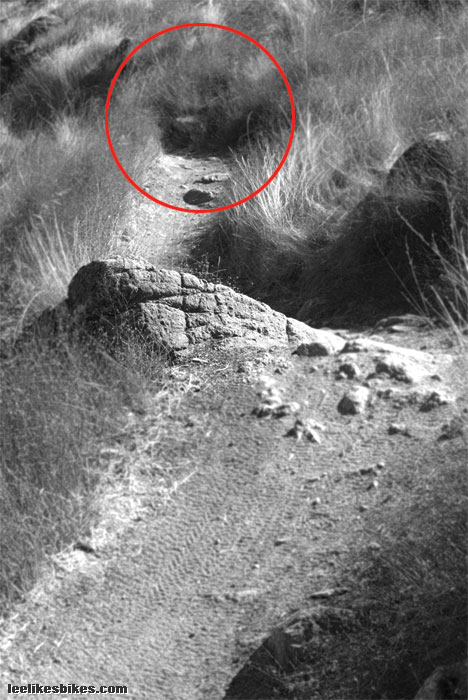The Way of Looking Ahead

Hi Lee,
Hope you don’t mind answering a couple questions from more of a beginners perspective. The best piece of advice I got from your book is also the hardest one for me to consistently achieve – looking farther down the trail – especially on rocky technical climbs.
If I look at a rock before I pedal over it, I fall every time, look ahead and I pedal right over it. It’s totally counterintuitive – especially to someone 40 yrs old. Feels like I am forcing myself to constantly keep my head up and ignore potentially dangerous obstacles. The question is, is this simply psychological? It feels like when I look at an obstacle everything is the same, cadence, position on the bike etc.
Thanks, Mike
 Scan to the next turn, and let your peripheral vision handle the one right in front of you. This will make you ride smoother and straighter. The money line here is right over the rock. |
Hey Mike,
The No. 1 most important skill in riding (and in life) is looking forward to where you want to go. This is also the No. 1 thing we all fail to do.
Reasons to look where you want to go:
1. Your brain will take you wherever you’re looking. If you stare at the rock in front of you, you will likely stop there. If you scan past the rock into that sweet turn, you will likely go there.
2. Your detailed vision is great at deciding where to go next, but it is bad at tracking motion and controlling your muscles. That’s what your peripheral vision is for. Once you’ve identified an obstacle, keep scanning forward to the next one. Let your peripheral vision track what’s below you. You don’t look at every step on a flight of stairs, do you?
3. Looking forward helps maintain proper balance over your feet. When you look down at that rock, you tend to curl forward and put too much weight on your bars. Not good.
We all agree you need to look where you’re going, so why is it so hard? Our failures are indeed psychological, but that doesn’t make them any less real.
The Way of Looking Ahead:
1. Master your core skills. Position, braking, cornering, pump and vision. When you’re on trail, pick specific reference points: usually the entrance to the next turn, definitely beyond that big rock. Look ahead and let your body and bike do their thing.
2. Gradually build your confidence. To ride any obstacle well, it must be a non-issue. Start small and slow, and work your way up. Over time, you will learn to scan right over bigger and bigger obstacles at higher and higher speeds.
3. Push (gently) against your boundaries. We all have a threshold where we stare at the obstacle, get tense and start to suck. Acknowledge this. I can easily float off a 5-foot drop with perfect form and no worries. When drops get closer to 10 feet, I start to stare and get nervous. I can either concentrate on perfect technique and go for it, or I can take another route. I frequently choose the latter.
Years ago I was with Brian Lopes at the Sheep Hills dirt jumps in SoCal. Everything was big and peaky and pros were flying everywhere, and I was scared to hit anything. “Yeah, I know how you feel,” Brian said. “On the moto I get nervous when the jumps get up around 80 feet.” We all have a threshold. His is now way past that. And yours will soon grow beyond that one big rock.
Master your skills. Work up gradually. Have fun. Say braaap!
— Lee
More info in Mastering Mountain Bike Skills.

Comments are closed.